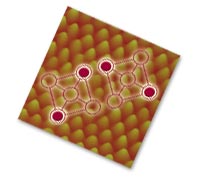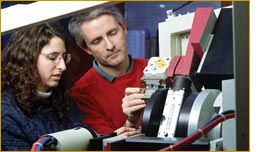

The Connection Between Education and Research Research laboratories and teaching-learning facilities rarely share the
same space, which is ironic considering that they are interdependent
in nature. Research laboratories and teaching-learning facilities rarely share the
same space, which is ironic considering that they are interdependent
in nature.The University’s new Multidisciplinary Engineering Education and Research Building, however, will not only provide unique learning areas for all engineering students, but it will also house two unique research centers. An important benefit of locating the learning center as a central element in the new engineering building is the exposure it will provide for all engineering undergraduates to two highly visible emerging technologies: nanoscience and molecularly based materials synthesis.  The Center for Nano Science and Technology explores a wide variety of
fundamental concepts in nanoscience and engineering with emphasis on
molecular-based nanostructures, device concepts and modeling, nanofabrication
characterization, image and information processing, and functional systems
design, including the development of future generations of computing,
optical, and information storage technologies. The center is the only
research facility in the country addressing nano-computing capabilities
using Quantum-dot Cellular Automata (QCA), which was pioneered at Notre
Dame. The Center for Nano Science and Technology explores a wide variety of
fundamental concepts in nanoscience and engineering with emphasis on
molecular-based nanostructures, device concepts and modeling, nanofabrication
characterization, image and information processing, and functional systems
design, including the development of future generations of computing,
optical, and information storage technologies. The center is the only
research facility in the country addressing nano-computing capabilities
using Quantum-dot Cellular Automata (QCA), which was pioneered at Notre
Dame. The multidisciplinary center is comprised of researchers from the departments of electrical engineering, computer science and engineering, chemistry and biochemistry, and physics. Facilities in the new building will include Class 100 clean rooms for nanodevice and circuit fabrication, nanolithography, and scanning tunneling microscopy. Wolfgang Porod, Frank M. Freimann Professor of Electrical Engineering, is the center’s director. For more information on the center, visit http://www.nd.edu/~ndnano.  The main function of the Center for Molecularly Engineered Materials (CMEM)
is two-fold: to develop materials and systems whose structure and components
exhibit novel and significantly improved physical, chemical, and biological
properties, phenomena, and processing, and to train students in emerging
materials technologies. According to Arthur J. Schmitt Professor of Chemical
Engineering Arvind Varma, the center’s
director, “The fact
that we’re focusing on materials -- such as fuel cells, catalysts,
biomaterials, and sensors -- and changing them at the molecular level
to obtain desired properties and performance is what makes the center unique.” CMEM
draws researchers from the departments of chemical engineering, aerospace
and mechanical engineering, chemistry and biochemistry, physics, and the
University’s Radiation Laboratory. For additional information, visit
http://www.nd.edu/~cmem. The main function of the Center for Molecularly Engineered Materials (CMEM)
is two-fold: to develop materials and systems whose structure and components
exhibit novel and significantly improved physical, chemical, and biological
properties, phenomena, and processing, and to train students in emerging
materials technologies. According to Arthur J. Schmitt Professor of Chemical
Engineering Arvind Varma, the center’s
director, “The fact
that we’re focusing on materials -- such as fuel cells, catalysts,
biomaterials, and sensors -- and changing them at the molecular level
to obtain desired properties and performance is what makes the center unique.” CMEM
draws researchers from the departments of chemical engineering, aerospace
and mechanical engineering, chemistry and biochemistry, physics, and the
University’s Radiation Laboratory. For additional information, visit
http://www.nd.edu/~cmem.Working in tandem with researchers in the Center for Nano Science and Technology and CMEM, faculty and staff in the Materials Characterization Facility will provide extensive characterization of materials from one angstrom to several centimeters in length. The facility will assist the identification of atomic/electronic structure and species concentrations of materials to parts-per-billion levels. Microstructural features as observed on polished, etched, fractured, and other degraded surfaces will be photographed and stored for analysis and application by University researchers. For more information, visit http://www.nd.edu/~cmem. |